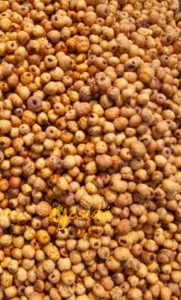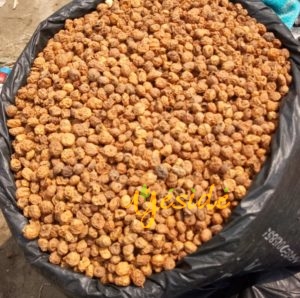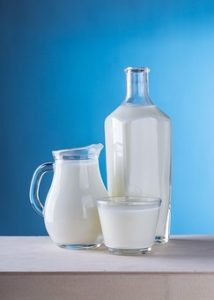
Tiger Nut or Yellow nutsedge is a tuber (like yam is a tuber) and technically not a nut as in the case of groundnut. It, however, has some similarities with nuts as it does with tubers.
Tiger nut is also called Chufa, Nut grass and earth almond. In Nigeria, It is called Ofio (in Yoruba), Aki Hausa (Igbo), and Aya (in Hausa).
Tiger Nut or Yellow Nutsedge belongs to the scientific genus Cyperus. Many plants under this genus are weeds. Interestingly, yellow nutsedge or Tiger nut as it is popularly called in Nigeria is also a weed.
In Nigeria, there are 3 varieties: Black, brown and yellow. The yellow is the most common variety.
Remarkably, tiger nut is said to originate from Southern Europe but has naturalized in countries like Ghana, Nigeria and Sierra Leone. In Some countries, it is used as beverages such as in Spain where Horchata de Chufa (Tiger nut milk drink) is popular, and in Nigeria, Kunnu Aya. Some other countries like the US use it as feed to attract animals such as turkey. Apart from turning it into a drink, Tiger nut can also be roasted and eaten. A popular snack eaten in the North of Nigeria is Dakuwa Aya, made from tiger nuts and groundnuts.
Interestingly, tiger nut is an ancient crop. As a matter of fact, jars of tiger nuts where found by archeologists in graves of pharaohs. It was also used to embalm bodies of these pharaohs.

What does it contain?
A 100g of fresh tiger nuts would give about 304kcal. Most of its calories are from oil and carbohydrates. It also contains small amount of protein. Like Tubers, it has high carbohydrate content (34.3g). The fat content is about 15.5g, most of which is unsaturated (oleic acid and linolenic acid like you will find in Egusi oil and many others). It also contains saturated oils (palmitic and stearic acid like you find in palm oil).The oil is used often in cosmetic industry because of its high vitamin E content.
Also, the fibre content of the tuber is high while the micronutrients it contains are in very small quantities.
Can Tiger Nut milk Be a replacement for Regular cow milk?
Some of the reasons why people might want a replacement for the regular cow milk are that they are lactose intolerant, they want to abstain from animal products (like vegans do), and they prefer something else.

The best way to answer the question is to compare tiger nut milk with cow milk. Currently, I don’t have enough data for tiger nut milk so I am just going to compare based on information available to me.
Tiger nut milk is of plant origin while cow milk is of animal origin. The protein in cow milk is of more quality than tiger nut milk because the amino acid profile of cow milk is complete as it is with protein from animal sources. Like most plants, their amino acid content is limiting in some essential amino acids. However, it still contains an appreciable amount of protein (smaller than cow milk though) and can add to protein intake of those who cannot take cow milk.
100g of whole cow milk powder contains about 495kcals of energy from carbohydrates (37.9g), Fat (26.6g) and protein (25.9g). It contains no fibre, lots of calcium, potassium and some other micronutrients. However, please note that this is concentrated milk powder that would be diluted in water (and 100g of it is a lot). Fresh cow milk on the other hand provides just about 165kcal, 4.25g of protein and 16.4g of fat.
A 2007 study by Belewu and Belewu showed that Tiger nut milk (without added sugar) contains about 26% fat, and 8% protein.
Another point to look at is the calcium content. Recommended amount of calcium for children and adults range between 700mg-1300mg in one day. 100g of fresh Tiger nuts contain just 20mg (of which you may not finish consuming all of the 100g). So, as a source of calcium, Tiger nut is not so great.

In terms of taste, tiger nut has a nutty and appealing flavor quite different from the cow milk. The milk is also cream in colour unlike cow milk’s white (for regular and not evaporated milk).
In terms of microbial quality, a number of research shows that harmful microtoxins easily get into the product while processing. This is the same for cow milk hence the reason it is pasteurized and treated to ensure safety. Since Nigeria mostly imports milk, most of it has undergone treatment to ensure safety and long shelf life.
Bottom Line:
Tiger Nutsedge is an oil-rich tuber which can be used to produce a nourishing Milk drink. The protein quantity and quality might be lower than that of cow milk but for those who are losing for an alternative to cow milk for whatever reason, it can supply you with some nutrients.
Looking at its strengths, the tiger nut milk contains a good amount of vitamin E and C which are important vitamins the body needs.
The onus lies on you to ensure that you get more protein and calcium from other sources to complement what you are getting from the Tiger nut milk.
Some Notes:
- Belewu, M.A. and Belewu, K.Y. (2007). Comparative physico-chemical evaluation of tigernut, soybean and coconut milk sources. Int. J. Agric. Biol., 9: 785- 787.
- West African Food Composition Table 2012
- Nigerian Food Composition Table 2017



Nice. Thanks for this write up. I wonder why people think tiger nuts are good for weight management. 360g seems like a lot to me. And as a side snack I’m sure Id be taking more.
Thanks. Tiger nut is a great side snack.
Wow! Thanks for this much needed info, Yeside!!! I remember “ofio” and enjoyed eating it as a child and like many other foods, I didn’t know it’s English name… Presently, the “food fad” in Nigeria is tiger nut milk being marketed as an alternative to cow milk, but your piece has clarified it and cleared my skepticism. I do think tiger nut milk is a good addition, but certainly not a substitute to cow milk considering its high carb content and low protein, calcium and Vitamin D contents, when compared to cow milk. So, I’m sticking with dairy milk as a major player in my nutrition and will continue eating ofio as a snack.